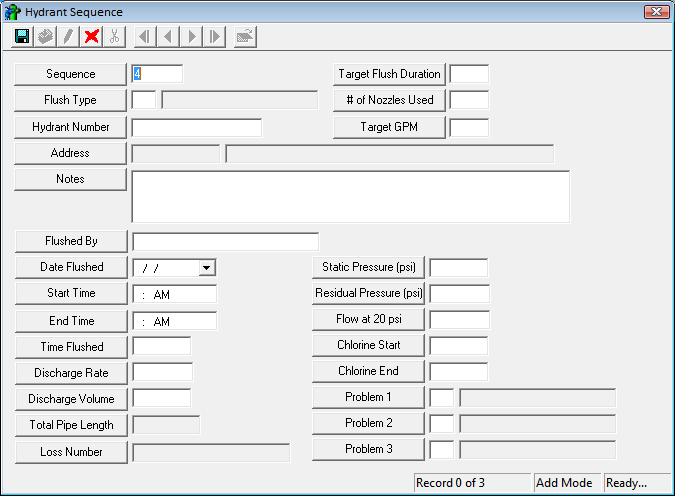
Hydrants to Flush records provide information about each hydrant on the flushing route and enable users to document the results of the flush.

Sequence |
Notes the order in which the hydrant is to be flushed within the route. |
Flush Type |
Indicates the type of flush to be performed. |
Hydrant Number |
Displays the hydrant's user-defined ID. Click the field caption button or press F9 for list of Hydrant records. |
Address |
Specifies the address at which the hydrant is located. Automatically populated from the Address fields in the Hydrant record's header. |
Notes |
Provides information about flushing this particular hydrant. Automatically populated from the Flushing Comment on the Hydrant record's Custom tab. |
Target Flush Duration |
Indicates the amount of time that the hydrant should be flushed. Automatically populated from the related Hydrant records on the flushing route. |
# of Nozzles Used |
Indicates the number of hydrant nozzles that should be used during the flush. Automatically populated from the related Hydrant record on the flushing route. |
Target GPM |
Indicates the rate at which the hydrant should be flushed. Automatically populated from the related Hydrant record. |
Flushed By |
Names the employee who flushed the hydrant. |
Date Flushed |
States the date on which the flush occurred. |
Start Time |
Specifies the time the flush started. |
End Time |
Specifies the time the flush ended. |
Time Flushed |
Calculates the amount of time (in minutes) it took to flush the hydrant based on the Start Time and End Time. |
Discharge Rate |
Indicates the rate at which water left the system (in gallons per minute). |
Discharge Volume |
States the amount of water flushed out the of the system. Calculated as: Discharge Rate x Time Flushed. Note: Users can enter this value manually or recalculate it using the F5 key. |
Total Pipe Length |
Calculates the amount of pipe cleaned during the flush by adding the lengths of all pipes in the Pipes Cleaned grid associated with the hydrant. |
Loss Number |
Displays the number for the Water Loss record the system generates to track the water flushed out of the system. |
Static Pressure (psi) |
Records the water pressure in the system when no water is being flushed. |
Residual Pressure (psi) |
Records the water pressure at the hydrant when another hydrant is being flushed. |
Flow at 20 psi |
Indicates the number of gallons per minute that would flow under a pressure of 20 psi. Calculated as: Discharge Rate x [(Static Pressure - 20)/(Static Pressure - Residual Pressure)]^.54 |
Chlorine Start |
Specifies the amount of chlorine measured at the start of the process. |
Chlorine End |
Specifies the amount of chlorine measured at the end of the process. |
Problem 1 Problem 2 Problem 3 |
Indicates agency-defined problems that should be noted during the flushing. |